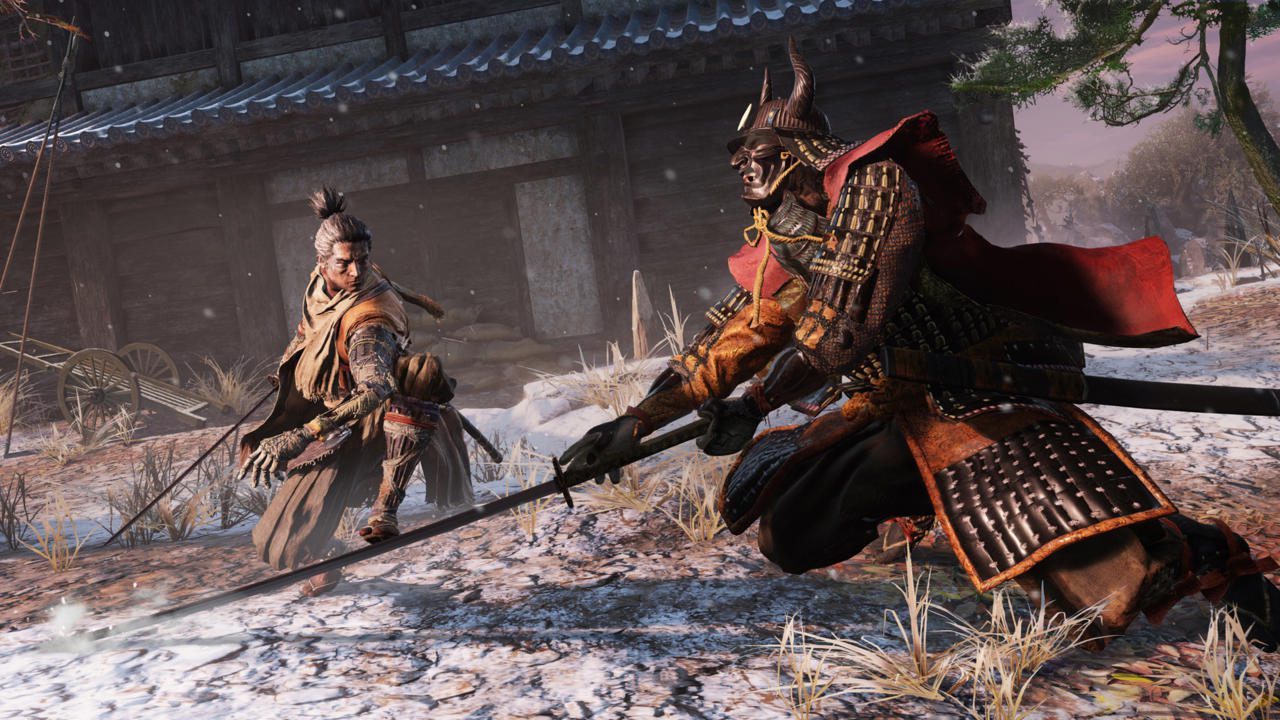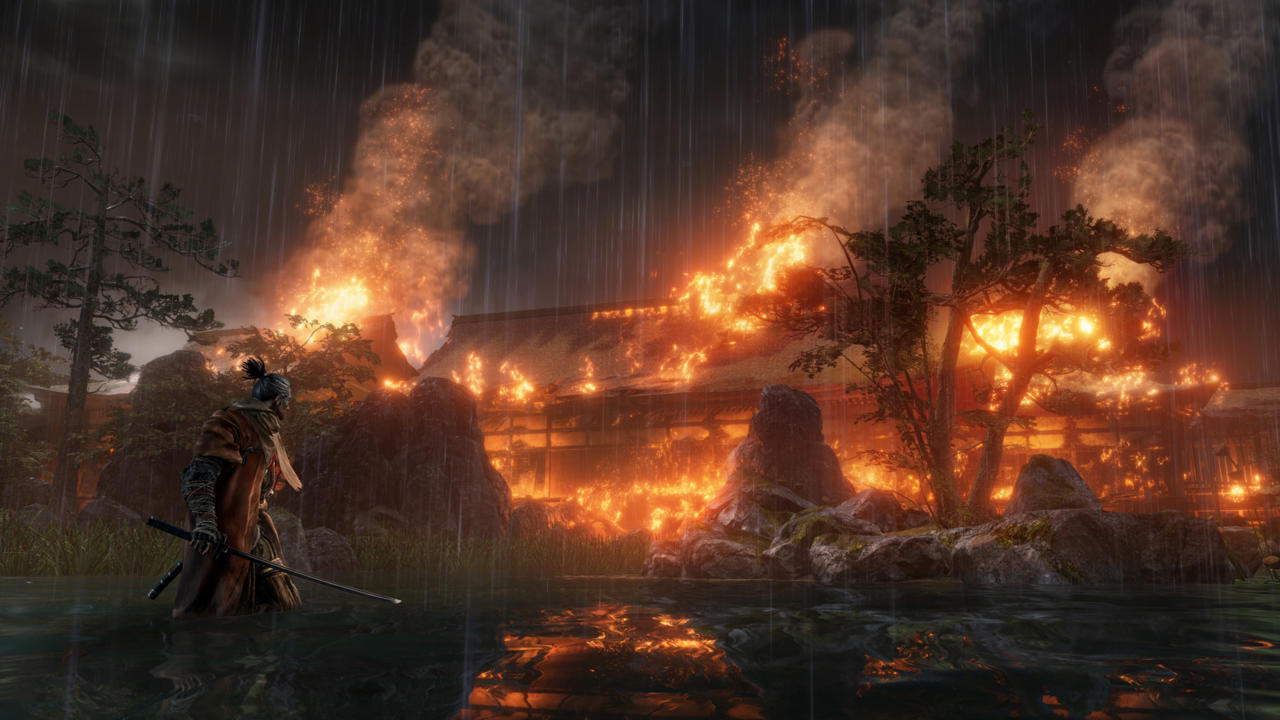Looking at From Software’s Sekiro: Shadows Die Twice, it’s clear that it’s built on the foundations of the team’s previous work on the Dark Souls series. Focusing on an uncompromising and stoic design sense that rewards patient players who learn from their mistakes, the developer’s next big title definitely channels some of the best of what their last ten years of games have to offer. However, Sekiro is a major shift away from the slower, and more cautious playstyle of action-RPG Dark Souls and even Bloodborne–moving further into the direction of what seems to be a traditional action game.
In Sekiro, you’re tasked with using some unorthodox gadgets, a sharp blade, and a ninja’s cunning and agility to overcome foes that can drop you in only a few strikes. Just prior to Gamescom, we dove into a brief section of Sekiro, which showcased the unique combat and stealth encounters, and got an idea of how it recontextualizes the Souls-formula into a stealth-action experience.

Set in a heavily fictionalized take on Sengoku-era Japan in 1500, you play as a shinobi who faces a brutal defeat at the hands of a rival samurai, losing their left arm in the process. Defying death, the warrior is given a new arm by a mysterious monk who names him the „One-Armed Wolf“. From here, the main character begins his quest for revenge against the samurai and his clan that roam the lands. But during his adventure, he’ll encounter other dangerous beasts and larger than life monsters, slowly revealing a much greater threat that will push his shinobi training to its limits.
Unlike From Software’s past titles, Sekiro focuses on the story of a defined character, and with stripped down RPG mechanics–there’s a greater emphasis on the more action-oriented gameplay and smart use of the tools you have on hand. As more of a spiritual successor to From Software’s previous games–which were also directed by Hidetaka Miyazaki–many of the familiar touchstones from the Souls games remain intact–but with many notable differences.
At its heart, Sekiro is a stealth-action game, and many encounters involve getting the jump up on unsuspecting enemies for quick and efficient kill, or by avoiding packs of foes altogether. With the One-Armed Wolf’s grappling hook, there’s a stronger focus on verticality and movement throughout the levels, where gaining the high-ground above your opponents can mean all the difference in your chances for survival. Though you’re certainly free to engage them head-on, most areas are heavily guarded, and you can easily find yourself outmatched by ranged foes and close-range fighters. The enemies in Sekiro are incredibly aggressive, and they prefer to fight in numbers.
You need a javascript enabled browser to watch videos.
10 Minutes Of Sekiro: Shadows Die Twice Gameplay | Gamescom 2018
Please use a html5 video capable browser to watch videos.
This video has an invalid file format.
Sorry, but you can’t access this content!
Please enter your date of birth to view this video
By clicking ‚enter‘, you agree to GameSpot’s
Terms of Use and Privacy Policy
During my time with Sekiro, I was impressed with the versatility of the game’s main character, which quickly asked you to learn the ins and outs of his arsenal. With the ability to sneak, hug walls, climb steep surfaces, and even jump, the protagonist’s skills give him an incredible amount of flexibility and range, allowing you to uncover hidden vantages above groups of enemies, or secret encounters off the beaten path–such as a Shinobi-hunting monk who’s immune to many of the Wolf’s tricks. But the protagonist’s most valuable tool in his arsenal is the Shinobi Prosthetic, which acts as your all-in-one support item, akin to Bloodborne’s trick weapons. Allowing you to toss shurikens, spew fire, blind foes, and unleash a powerful axe that can break through enemy defenses, the One-Armed Wolf can pull off all sorts of clever moves on the fly–such as igniting your sword on fire to add extra damage.
Like other titles from the Souls series, death plays a large role in Sekiro. While the One-Armed Wolf is an extremely lethal fighter with gadgets and weapons that allow him to kill most common enemies in only a single blow, he’s extremely vulnerable as well. While you’re certainly able to face off against groups of foes, it’s usually the smarter option not to. During one challenging section, I entered a courtyard with several guards trying to a contain an imprisoned Ogre, only to be spotting by ranged bowmen who had the high ground. With the stealthy approach out the window, I tried to engage each target one-by-one–but then the Ogre broke free and joined the fight. What followed was a cascade of violent blows and flying arrows–culminating in the large Ogre powerbombing me and tossing me like a ragdoll.
You’ll die a lot in Sekiro. But as the subtitle of the game suggests, there’s more to death than what it seems. Referred to as the Resurrection mechanic and used as somewhat of a tactical respawn, you’re able to use up a life token (two at max)–found from resting at Sculptor’s Idols, essentially bonfires–to instantly revive on the spot and pick up where you left. In most situations, you can wait for enemies to walk away, revive, and then sneak up for a kill when their guard is down. But of course, if the situation looks too dire–some enemies will choose to stick around your body–you can accept your death instead, which will send you back to the nearest Sculptor’s Idol. And of course, all common foes will return after visiting the rest point, forcing you to take on that familiar gauntlet once again.

Eventually, you’ll come across elite foes that guard the only path forward. These mid-bosses are among the more dangerous opponents you’ll encounter, and battling them feels more like a game of wits and quick reflexes, rather than brute force. Much like stealth gameplay, melee combat is all about taking advantage of your opponent’s vulnerabilities. With the Posture System, aggressive attacks, timed parries and blocks will add pressure to your opponent. Once the Posture gauge tops out, they’ll enter a stunned state, opening them up to critical attacks. However, the elite enemies can do the same to you, which will decimate your life bar in a single blow.
There were definitely a lot of surprises to be found in this relatively modest demo for the game. After passing through the castle grounds, we entered a large canyon guarded by a massive snake. With the only way forward ahead of it, we had to time our jumps and grapples correctly to enter small cave in time to evade its attacks. Soon after, we faced off against the demo’s boss on a bridge surrounded by sparkling red trees–one of the demo’s most visually stunning areas. Known as the Cursed Monk, this multi-phased fight forces you to use every skill you have–even grappling to higher ground to avoid attacks. It was easily the hardest fight in the demo, and unsurprisingly, we couldn’t beat it.


After playing more than half-an-hour of the game, it’s clear that the roots of the Souls genre are still there–yet it’s undeniably its own beast. One of the more common sensations felt when playing games like Dark Souls and Bloodborne is the sense of apprehension and dread. While those feelings are still present in Sekiro to an extent, the tools and skills that the protagonist possessed gave me much more of an empowered feeling throughout. Having said that, there’s still much we have to learn about Sekiro, and just how far it will go with its mashup of stealth-action gameplay and the best of what the Souls series is all about.
For more on our continuing coverage of Gamescom 2018, which includes our hands-on impressions of Devil May Cry 5 and Hitman 2, be sure to check out GameSpot’s hub page for all the latest news and videos.
Website: LINK


